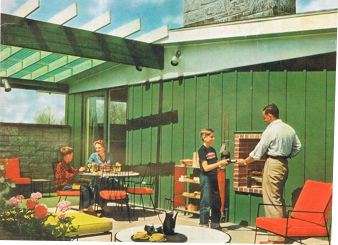Glenbrook Valley in Houston Texas gets Groundbreaking Historic Designation
In 1956 Glenbrook Valley was just hitting its stride. The Parade of Homes had singled out the residential area, exclusively featuring Glenbrook Valley for all 30 homes on their annual tour. The development had previously been included in a citywide Parade of Homes in 1954, but not for the entire event.
Nestled along Sims Bayou between I45 and Telephone Rd., Glenbrook Valley originally opened in 1953 with a lot of fanfare. It was designed by the renowned Kansas City landscape architecture firm Hare and Hare, which was known for many Houston layouts, including River Oaks. The subdivision also received a lot of interest when Better Homes and Gardens featured 7923 Glenview on the September 1954 cover for an article titled “The Home for All America” and was the prize home for the 1954 Parade of Homes.
By 1956, Glenbrook Valley was steadily becoming the go-to neighborhood for up-and-coming Houstonians. The 1956 Parade of Homes brochure described the houses and gave each one a name to express their individuality. “The Suburban Styline,” “Lowe’s Electric All Electric Home,” “House of Ideas” and “Casa Manana” alluded to their modern amenities. “Holiday House,” “Tex-O-Rama,” “Modern Junior Executive” and “Greener Pastures” appealed to the variety of personalities who may choose to move there.
Fast forward to today. Glenbrook Valley can now add another accolade to its rich history. It has just received what no other atomic era development in Texas ever has — designation as the first post-World War II historic district in Texas. The Houston City Council voted June 29 and the historic district was approved by a 10 to 4 vote. It is also Houston’s first district outside the 610 loop and, with over 1250 homes, the largest of the 18 other historic districts.
Many 1950s era homes are gone forever from inner-loop neighborhoods. However, over 90 percent of the original homes built in Glenbrook Valley still exist today. These mid-century modern and American ranch style homes now have the City of Houston behind them. None of the houses can be torn down without approval from the city and must maintain their architectural integrity, although the interiors can be redesigned without restrictions.
Ranch style houses built in the 1950s are single story homes with low rooflines, usually built with an attached garage or carport. Ranch style houses have fewer doors and hallways than earlier homes, with kitchens that were designed to accommodate the modern appliances of the day. These homes have large windows and sliding glass doors that lead to the back yard where families would spend much of their leisure time. “Mid-century modern” is a term coined decades later for houses that build upon ranch style architecture. Many have floor-to-ceiling windows, open floor plans and flat roofs.
The complete article was original featured on 2m Realty.

